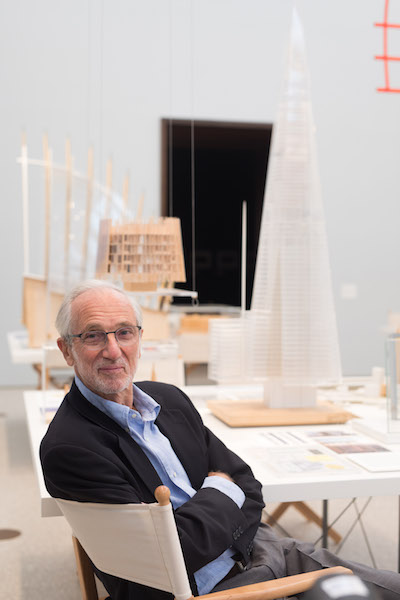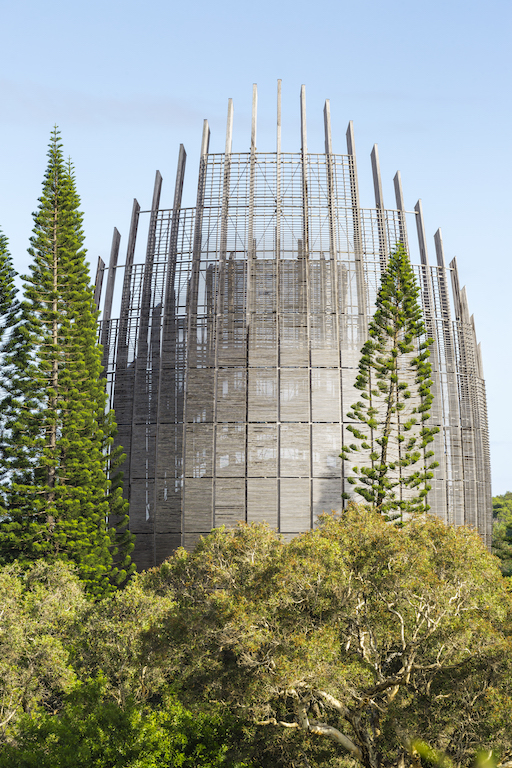Renzo Piano, Royal Academy review - worth the effort | reviews, news & interviews
Renzo Piano, Royal Academy review - worth the effort
Renzo Piano, Royal Academy review - worth the effort
Church spires informed the shape of the Shard

Architecture is notoriously difficult to present in an accessible way and this survey of Italian architect Renzo Piano, who gave London the Shard, does not solve the problem.
Subtitled The Art of Making Buildings, it tells the story of 16 projects from the point of view of the design team. Drawings, photographs, models, letters and magazine articles provide insight into the unique challenges posed by each commission and the solutions arrived at to deal with them.
 Chairs are provided to encourage you to linger and sift through the information, but it takes an act of will to sit down and concentrate. Luckily a film by Thomas Riedelsheimer offers another way into the mind of Renzo Piano. Speaking with enormous clarity about his approach to building and his beliefs about the importance of his profession, Piano is a delight to listen to.
Chairs are provided to encourage you to linger and sift through the information, but it takes an act of will to sit down and concentrate. Luckily a film by Thomas Riedelsheimer offers another way into the mind of Renzo Piano. Speaking with enormous clarity about his approach to building and his beliefs about the importance of his profession, Piano is a delight to listen to.
Born in Genoa in 1937, he adores sailing. He built his first boat as a young boy and has made five more since then, each one a little larger than the last. A photo taken of him in fancy dress, in 1987, shows him attempting to steer a clunky boat made from a dismembered wardrobe. It was his entry into a race set up for the staff of his Building Workshop in Genoa, in which all vessels had to be made for less than $100. Its probably a good thing that that anarchic sense of fun is absent from the work. In its place is the precision and economy needed to design and build a serious sailing boat. Piano (pictured right by David Parry with a model of the Shard) describes his buildings as “flying vessels” and, having watched his elegant yacht glide past under full sale, you begin to notice the same spare elegance in the buildings and to spot shapes reminiscent of masts and sails, hulls and rigging. In an aerial shot of the Shard taken by Chris Martin (pictured below left), the gleaming glass tower resembles a sailing ship floating over the rooftops of London towards the sunset.
The display tells you about the eight overlapping facets that form London’s tallest building, whose conical shape was influenced by our church spires. Six different types of glass were used for the double glazed interior units and two more for the outer glass skin; this variety allows the structure to reflect the ever changing light at different times of day and in all weathers. “Lightness is not just a physical event”, says Piano. “Beauty is one of the few things that can change the world.“
 "Architecture is the art of making a place for people”, he adds. “You need to understand why you are doing things; you need to be a humanist.” Yet there is precious little in the exhibition about other people’s experience of his buildings. Why are there so few photographs of the actual buildings and no videos walking you round the outside or taking you through the interior spaces? Does Piano always succeed in his goal of making beautiful and uplifting structures ? From an aeroplane the Shard may look light, ethereal and mysterious, but the view from the ground is very different. Towering over the walkway leading to London Bridge station, the building makes the meagre space at its base feel cramped and oppressive.
"Architecture is the art of making a place for people”, he adds. “You need to understand why you are doing things; you need to be a humanist.” Yet there is precious little in the exhibition about other people’s experience of his buildings. Why are there so few photographs of the actual buildings and no videos walking you round the outside or taking you through the interior spaces? Does Piano always succeed in his goal of making beautiful and uplifting structures ? From an aeroplane the Shard may look light, ethereal and mysterious, but the view from the ground is very different. Towering over the walkway leading to London Bridge station, the building makes the meagre space at its base feel cramped and oppressive.
 Standing in a niche on the staircase leading to the exhibition is a wooden structure resembling a sled. Its a model for the walls of one of Piano’s most interesting projects – the Jean-Marie Tjibaou Cultural Centre, built in 1998 near Nouméa in New Caledonia (pictured right by Sergio Grazia). A celebration of Kanak culture, the centre consists of ten pavilions inspired by traditional Kanak dwellings made from a wooden framework interlaced with plant fibres. Using iroko, a wood too hard even for termites to chew, Piano created an elegant modern equivalent. Two layers of slatted wood are held in place by steel braces. Adjustable louvers let the wind blow through the slats to alleviate the oppressive humidity of the semi-tropical climate. Rising above the surrounding trees like woven baskets the bowl shaped structures provide a fitting arena for theatre, music, dance and a library.
Standing in a niche on the staircase leading to the exhibition is a wooden structure resembling a sled. Its a model for the walls of one of Piano’s most interesting projects – the Jean-Marie Tjibaou Cultural Centre, built in 1998 near Nouméa in New Caledonia (pictured right by Sergio Grazia). A celebration of Kanak culture, the centre consists of ten pavilions inspired by traditional Kanak dwellings made from a wooden framework interlaced with plant fibres. Using iroko, a wood too hard even for termites to chew, Piano created an elegant modern equivalent. Two layers of slatted wood are held in place by steel braces. Adjustable louvers let the wind blow through the slats to alleviate the oppressive humidity of the semi-tropical climate. Rising above the surrounding trees like woven baskets the bowl shaped structures provide a fitting arena for theatre, music, dance and a library.
Renzo Piano’s father and grandfather were both builders, and he describes architecture as a step by step process of addressing one challenge after another, always trusting that you will find an elegant solution. In helping to elucidate that process, this exhibition is not only informative but it should act as an inspiration for all wannabe architects. “To be creative you just have to decide”, says Piano. ”To be creative, you jump!” But in focusing primarily on the view from inside the Workshop, it overlooks the other side of the equation – the view from the street.
rating
Buy
Explore topics
Share this article
The future of Arts Journalism
You can stop theartsdesk.com closing!
We urgently need financing to survive. Our fundraising drive has thus far raised £49,000 but we need to reach £100,000 or we will be forced to close. Please contribute here: https://gofund.me/c3f6033d
And if you can forward this information to anyone who might assist, we’d be grateful.

Subscribe to theartsdesk.com
Thank you for continuing to read our work on theartsdesk.com. For unlimited access to every article in its entirety, including our archive of more than 15,000 pieces, we're asking for £5 per month or £40 per year. We feel it's a very good deal, and hope you do too.
To take a subscription now simply click here.
And if you're looking for that extra gift for a friend or family member, why not treat them to a theartsdesk.com gift subscription?
more Visual arts
 'We are bowled over!' Thank you for your messages of love and support
Much-appreciated words of commendation from readers and the cultural community
'We are bowled over!' Thank you for your messages of love and support
Much-appreciated words of commendation from readers and the cultural community
![SEX MONEY RACE RELIGION [2016] by Gilbert and George. Installation shot of Gilbert & George 21ST CENTURY PICTURES Hayward Gallery](https://theartsdesk.com/sites/default/files/styles/thumbnail/public/mastimages/Gilbert%20%26%20George_%2021ST%20CENTURY%20PICTURES.%20SEX%20MONEY%20RACE%20RELIGION%20%5B2016%5D.%20Photo_%20Mark%20Blower.%20Courtesy%20of%20the%20Gilbert%20%26%20George%20and%20the%20Hayward%20Gallery._0.jpg?itok=7tVsLyR-) Gilbert & George, 21st Century Pictures, Hayward Gallery review - brash, bright and not so beautiful
The couple's coloured photomontages shout louder than ever, causing sensory overload
Gilbert & George, 21st Century Pictures, Hayward Gallery review - brash, bright and not so beautiful
The couple's coloured photomontages shout louder than ever, causing sensory overload
 Lee Miller, Tate Britain review - an extraordinary career that remains an enigma
Fashion photographer, artist or war reporter; will the real Lee Miller please step forward?
Lee Miller, Tate Britain review - an extraordinary career that remains an enigma
Fashion photographer, artist or war reporter; will the real Lee Miller please step forward?
 Kerry James Marshall: The Histories, Royal Academy review - a triumphant celebration of blackness
Room after room of glorious paintings
Kerry James Marshall: The Histories, Royal Academy review - a triumphant celebration of blackness
Room after room of glorious paintings
 Folkestone Triennial 2025 - landscape, seascape, art lovers' escape
Locally rooted festival brings home many but not all global concerns
Folkestone Triennial 2025 - landscape, seascape, art lovers' escape
Locally rooted festival brings home many but not all global concerns
 Sir Brian Clarke (1953-2025) - a personal tribute
Remembering an artist with a gift for the transcendent
Sir Brian Clarke (1953-2025) - a personal tribute
Remembering an artist with a gift for the transcendent
 Emily Kam Kngwarray, Tate Modern review - glimpses of another world
Pictures that are an affirmation of belonging
Emily Kam Kngwarray, Tate Modern review - glimpses of another world
Pictures that are an affirmation of belonging
 Kiefer / Van Gogh, Royal Academy review - a pairing of opposites
Small scale intensity meets large scale melodrama
Kiefer / Van Gogh, Royal Academy review - a pairing of opposites
Small scale intensity meets large scale melodrama
 Jenny Saville: The Anatomy of Painting, National Portrait Gallery review - a protégé losing her way
A brilliant painter in search of a worthwhile subject
Jenny Saville: The Anatomy of Painting, National Portrait Gallery review - a protégé losing her way
A brilliant painter in search of a worthwhile subject
 Abstract Erotic, Courtauld Gallery review - sculpture that is sensuous, funny and subversive
Testing the boundaries of good taste, and winning
Abstract Erotic, Courtauld Gallery review - sculpture that is sensuous, funny and subversive
Testing the boundaries of good taste, and winning
 Edward Burra, Tate Britain review - watercolour made mainstream
Social satire with a nasty bite
Edward Burra, Tate Britain review - watercolour made mainstream
Social satire with a nasty bite
 Ithell Colquhoun, Tate Britain review - revelations of a weird and wonderful world
Emanations from the unconscious
Ithell Colquhoun, Tate Britain review - revelations of a weird and wonderful world
Emanations from the unconscious
